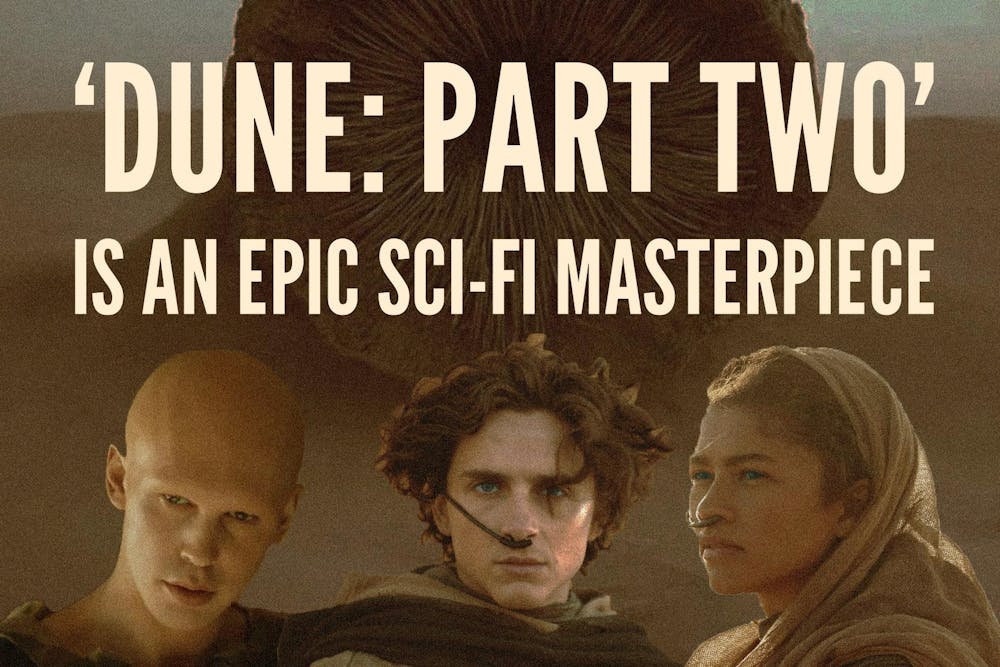Denis Villeneuve is one of the best directors currently working. His sci-fi films — “Arrival” and “Blade Runner 2049” — are phenomenal. They are visually stunning, yet they miraculously maintain intimate character work and profound themes. Thus, he was the perfect director to adapt “Dune,” a notoriously difficult book to bring to the screen. 2021’s “Dune: Part One” was a fantastic introduction to the world of Dune that successfully translated the book’s singularity to the big screen. Yet the film was only one half of a story, so it felt slightly sparse and incomplete. I had faith that Villeneuve would stick the landing with the sequel, but he has somehow managed to surpass even my wildest expectations. Visually staggering, narratively fascinating and superbly acted, ”Dune: Part Two” is an awe-inspiring epic that has instantly cemented itself as one of the greatest sci-fi films ever.
“Dune: Part Two” continues the gorgeous visual language Villeneuve and cinematographer Greig Fraser established in the first movie. The wide shots grandly capture the vast deserts of Arrakis and the towering brutalist machinery and buildings. The film’s ability to convey scale is exceptional and engulfs you in the unfamiliar world. Yet the film knows when to reel the scope in to capture intimate moments. Ultra close-ups of characters add weight to emotional exchanges. Throughout the movie, there are sequences that will have you paralyzed in your seat with awe. Paul riding his first sandworm is an overwhelming and visceral scene, immersing you in Paul’s initial struggle to gain control of the sandworm with palpable intensity and his eventual success with resounding triumph. The scenes on the Harkonnen planet are downright terrifying. The bleak black-and-white cinematography paired with the demonic and fascist aesthetic of Harkonnen society is bone-chilling, and the final battle with towering sandworms swallowing up thousands of soldiers is exhilarating to watch. Overall, the film is endlessly breathtaking and one of the best-looking blockbuster films ever.
Even beyond all this visual excellence, “Dune: Part Two” is densely packed with engaging themes and idiosyncratic lore. The world of Dune is a wonderfully audacious synthesis of eugenics, anti-colonialism, talking fetuses, trade wars, Islamic mysticism, psyops and more, all of which helps make the film’s examination of religion and politics powerful. The plot revolves around Paul’s transformation into the prophesied messiah as he becomes closer to the Fremen, the native people of Arrakis. Paul is the product of generations of meticulous breeding by the Bene Gesserit to produce a supernatural “messiah” that will transform the universe to their liking. To add credibility to their organization and plan, the Bene Gesserit have planted the prophecy of a foreign messiah into the local religions of various planets, including the Fremen on Arrakis. Thus, their crazed political agenda has transformed into a religion with millions of devout Fremen followers. This manipulative syncretism enables Paul and his mother, Lady Jessica, to easily hijack the revolutionary plans of the Fremen for their political gain. Paul is initially reluctant to assume this role and denies he is the messiah. Still, he eventually succumbs to his maniacal mother, the Fremen’s intense faith in him and his own desire for political revenge against the Harkonnens and Emperor. Paul’s arc is a powerful tragedy of a man who was never given a choice; he’s less a person and more a preconfigured vessel for all these political and religious forces. By the movie’s end, viewers see that Paul has transformed into a vicious ruler who has unleashed something incredibly dangerous into the world. Our protagonist wins, but you’re not happy about it. It’s a powerfully subversive ending.
The film is further elevated by its fantastic, astoundingly stacked cast. Timothée Chalamet gives a tremendous performance as Paul Atreides. He perfectly captures the character’s transformation from a shy teenager into a sinister, commanding leader. Rebecca Ferguson is deeply unsettling as the power-hungry Lady Jessica; the craziness in her eyes throughout the movie is hard to shake. Austin Butler is unrecognizable and terrifying as Feyd-Rautha Harkonnen but still manages to exude a childlike giddiness in the character that is fascinating to watch. Javier Bardem gives a surprisingly hilarious performance as Stilgar, a Fremen incredibly dedicated to Paul and the idea he is the messiah. His excessive admiration of Paul is funny and provides comedic relief in many scenes. Yet there comes the point when his zeal stops being funny and becomes unsettling as Paul uses believers like Stilgar to gain more and more power. Beyond these personal highlights, the film has many other talented actors giving great performances. The acting is one of the film’s greatest strengths, a remarkable feat considering it would be easy for the characters to become secondary to the film’s spectacle, but Villeneuve adeptly balances both.
“Dune: Part Two” is a medium-affirming film. It’s a reminder of the power movies have to transport us to entirely new worlds full of mystique and wonder. It’s a reminder of the star power that used to fuel the entire Hollywood system. It’s a reminder of the scale and splendor blockbuster movies are supposed to have. It’s a reminder that auteur-driven films produce the best results. We are so back.










